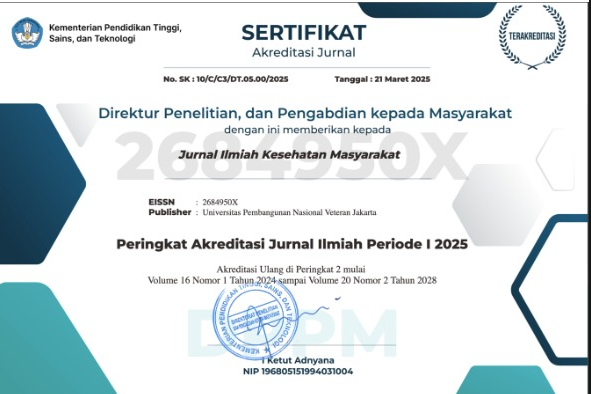Systematic Review: Pengaruh Jumlah Langkah per Hari terhadap Sindrom Metabolik pada Orang Dewasa dengan Kelebihan Berat Badan
Abstract
Latar Belakang: Kelebihan berat badan merupakan masalah kesehatan masyarakat yang cukup besar dialami orang dewasa dan kerap dihubungkan dengan sindrom metabolik karena keduanya disebabkan oleh gaya hidup yang buruk, seperti kurangnya aktivitas fisik. Literatur menyatakan bahwa salah satu cara mengatasi kelebihan berat badan ialah dengan melakukan aktivitas fisik seperti berjalan kaki. Walaupun demikian, belum terdapat systematic review mengenai pengaruh berjalan kaki sebagai usaha mengatasi kelebihan berat badan pada orang dewasa, terutama dalam menurunkan risiko sindrom metabolik. Oleh karena itu, penelitian ini bertujuan untuk melihat bagaimana pengaruh capaian langkah kaki harian terhadap penurunan faktor risiko penyebab sindrom metabolik pada orang dewasa dengan kelebihan berat badan.
Metode: Metode yang digunakan pada penelitian ini adalah systematic literature review dengan metode PRISMA (Preferred Reporting Items for Systematic Reviews and Meta-analyses) dan terdapat 43.915 jurnal. Setelah dilakukan eksklusi, ditemukan artikel yang sesuai tujuan penelitian kami sebanyak 6 jurnal artikel.
Hasil: Berdasarkan hasil telaah artikel, ditemukan adanya pengaruh jumlah langkah kaki terhadap perubahan indeks massa tubuh, lingkar pinggang, lingkar panggul, Rasio Lingkar Pinggang dan Panggul (RLPP), lemak tubuh, dan komponen biokimia, seperti trigliserida, HDL-C, dan gula darah sebagai indikator risiko sindrom metabolik. Meskipun begitu, terdapat penelitian lain yang inkonsisten terhadap dampak jalan kaki dengan penurunan IMT dan RLPP.
Kesimpulan: Berjalan kaki sebanyak lebih dari 5.000 langkah per hari memiliki efek menguntungkan dalam penurunan faktor risiko sindrom metabolik. Namun, untuk meningkatkan manfaat kesehatan yang lebih signifikan, perlu mempertimbangkan adanya variabel intensitas latihan, laju langkah, serta perbaikan gaya hidup seperti asupan makanan.
Kata Kunci: Jalan kaki, Kelebihan berat badan, Obesitas, Sindrom metabolik
Background: Being overweight is a major public health problem experienced by adults. It is often associated with metabolic syndrome. Both are caused by poor lifestyles, such as lack of physical activity. Some research stated that one way to overcome excess weight is to do physical activity such as walking. However, there has been no systematic review regarding the effect of walking as a solution to overcome excess weight in adults, especially in reducing the risk of metabolic syndrome. This study aims to see how daily walking steps influence in reducing risk factors that cause metabolic syndrome in overweight adults.
Methods: The method used in this research was a systematic literature review with the PRISMA method. It is found 43,915 journals. After the exclusion, 6 journal articles were found matched with our research objectives.
Result: Based on the results of the article review, it was found that there was an influence of the number of steps taken on changes in body mass index, waist circumference, hip circumference, Waist and Hip Ratio (WHR), body fat, and biochemical components, such as triglycerides, HDL-C, and blood sugar as metabolic syndrome risk indicator. However, there are other studies that are inconsistent regarding the impact of walking on reducing BMI and WHR.
Conclusion: Walking more than 5,000 steps per day has a beneficial effect in reducing metabolic syndrome. However, to increase more significant health benefits, it is necessary to consider the variables of exercise intensity, step rate, and lifestyle improvements such as food intake.
Keywords: Metabolic syndrome, Obesity, Overweight, Walking
References
WHO. Obesity and Overweight [Internet]. 2021 [cited 2023 Nov 25]. Available from: https://www.who.int/news-room/fact-sheets/detail/obesity-and-overweight.
Kemenkes. Laporan Riskesdas Nasional. 2018.
Han TS, Lean ME. A clinical perspective of obesity, metabolic syndrome and cardiovascular disease. JRSM Cardiovasc Dis [Internet]. 2016 Jan 1 [cited 2023 Nov 1];5:204800401663337. Available from: /pmc/articles/PMC4780070/.
Kip KE, Marroquin OC, Kelley DE, Johnson BD, Kelsey SF, Shaw LJ, et al. Clinical Importance of Obesity Versus the Metabolic Syndrome in Cardiovascular Risk in Women. Circulation [Internet]. 2004 Feb 17 [cited 2023 Nov 1];109(6):706–13. Available from: https://www.ahajournals.org/doi/abs/10.1161/01.cir.0000115514.44135.a8.
NHLBI. Metabolic Syndrome - Causes and Risk Factors | NHLBI, NIH [Internet]. 2022 [cited 2023 Nov 1]. Available from: https://www.nhlbi.nih.gov/health/metabolic-syndrome/causes.
Lee IM, Shiroma EJ, Lobelo F, Puska P, Blair SN, Katzmarzyk PT, et al. Effect of physical inactivity on major non-communicable diseases worldwide: an analysis of burden of disease and life expectancy. The Lancet. 2012 Jul 21;380(9838):219–29.
Tudor-Locke C, Craig CL, Brown WJ, Clemes SA, De Cocker K, Giles-Corti B, et al. How many steps/day are enough? for adults. Int J Behav Nutr Phys Act [Internet]. 2011 Jul 28 [cited 2023 Nov 1];8:79. Available from: /pmc/articles/PMC3197470/.
CQUniversity Australia. Getting Started | 10,000 Steps [Internet]. [cited 2023 Nov 1]. Available from: https://www.10000steps.org.au/.
Hall KS, Hyde ET, Bassett DR, Carlson SA, Carnethon MR, Ekelund U, et al. Systematic review of the prospective association of daily step counts with risk of mortality, cardiovascular disease, and dysglycemia. International Journal of Behavioral Nutrition and Physical Activity [Internet]. 2020 Jun 20 [cited 2023 Nov 1];17(1):1–14. Available from: https://ijbnpa.biomedcentral.com/articles/10.1186/s12966-020-00978-9.
Yuenyongchaiwat K. Effects of 10,000 steps a day on physical and mental health in overweight participants in a community setting: A preliminary study. Braz J Phys Ther. 2016 Jul 1;20(4):367–73.
Hernández-Reyes A, Cámara-Martos F, Molina-Luque R, Moreno-Rojas R. Effect of an mHealth intervention using a pedometer app with full in-person counseling on body composition of overweight adults: Randomized controlled weight loss trial. JMIR Mhealth Uhealth. 2020 May 1;8(5).
Hasan H, Attlee A, Jan Bin Jan Mohamed H, Aris N, Muda WAMBW. Counting Footsteps with a Pedometer to Improve HMW Adiponectin and Metabolic Syndrome among Young Female Adults in the United Arab Emirates. J Obes. 2018;2018.
Chiang TL, Chen C, Hsu CH, Lin YC, Wu HJ. Is the goal of 12,000 steps per day sufficient for improving body composition and metabolic syndrome? the necessity of combining exercise intensity: A randomized controlled trial. BMC Public Health. 2019 Sep 3;19(1).
Chiu YH, Tsai SC, Lin CS, Wang LY, Huang KC. Effects of a 12-week walking intervention on circulating lipid profiles and adipokines in normal weight and abdominal obese female college students. J Exerc Sci Fit. 2023 Jul 1;21(3):253–9.
Jahan N, Shenoy S. Relation of pedometer steps count & self-reported physical activity with health indices in middle aged adults. Diabetes and Metabolic Syndrome: Clinical Research and Reviews. 2017 Dec 1;11:S1017–23.
Zhu S, Wang ZM, Shen W, Heymsfield SB, Heshka S. Percentage body fat ranges associated with metabolic syndrome risk: results based on the third National Health and Nutrition Examination Survey (1988–1994). Am J Clin Nutr. 2003 Aug 1;78(2):228–35.
Abel M, Hannon J, Mullineaux D, Beighle A. Determination of Step Rate Thresholds Corresponding to Physical Activity Intensity Classifications in Adults. J Phys Act Health. 2011 Jan;8(1):45–51.
Tudor-Locke C, Sisson SB, Collova T, Lee SM, Swan PD. Pedometer-Determined Step Count Guidelines for Classifying Walking Intensity in a Young Ostensibly Healthy Population. Canadian Journal of Applied Physiology. 2005 Dec 1;30(6):666–76.
Anton SD, Duncan GE, Limacher MC, Martin AD, Perri MG. How Much Walking Is Needed to Improve Cardiorespiratory Fitness? An Examination of the 2008 Physical Activity Guidelines for Americans. Res Q Exerc Sport. 2011 Jun;82(2):365–70.
Ramírez-Vélez R, Correa-Bautista JE, Sanders-Tordecilla A, Ojeda-Pardo ML, Cobo-Mejía EA, Castellanos-Vega R del P, et al. Percentage of Body Fat and Fat Mass Index as a Screening Tool for Metabolic Syndrome Prediction in Colombian University Students. Nutrients 2017, Vol 9, Page 1009 [Internet]. 2017 Sep 13 [cited 2023 Nov 25];9(9):1009. Available from: https://www.mdpi.com/2072-6643/9/9/1009/htm.
Macek P, Biskup M, Terek-Derszniak M, Stachura M, Krol H, Gozdz S, et al.
Optimal Body Fat Percentage Cut-Off Values in Predicting the Obesity-Related Cardiovascular Risk Factors: A Cross-Sectional Cohort Study. Diabetes, Metabolic Syndrome and Obesity [Internet]. 2020 May 12 [cited 2023 Nov 25];13:1587–97. Available from: https://www.dovepress.com/optimal-body-fat-percentage-cut-off-values-in-predicting-the-obesity-r-peer-reviewed-fulltext-article-DMSO.
Hernández-Reyes A, Cámara-Martos F, Molina-Luque R, Moreno-Rojas R. Effect of an mHealth Intervention Using a Pedometer App With Full In-Person Counseling on Body Composition of Overweight Adults: Randomized Controlled Weight Loss Trial. JMIR Mhealth Uhealth [Internet]. 2020 May 1 [cited 2023 Nov 25];8(5). Available from: /pmc/articles/PMC7287728/.
Tudor-Locke C, Bassett DR. How Many Steps/Day Are Enough? Sports Med. 2004;34:1–8.
Grundy SM. Obesity, Metabolic Syndrome, and Coronary Atherosclerosis. Circulation. 2002 Jun 11;105(23):2696–8.
Hasan H, Attlee A, Jan Bin Jan Mohamed H, Aris N, Muda WAMBW. Counting Footsteps with a Pedometer to Improve HMW Adiponectin and Metabolic Syndrome among Young Female Adults in the United Arab Emirates. J Obes [Internet]. 2018 [cited 2023 Nov 25];2018. Available from: /pmc/articles/PMC6304855/.









.jpg)








